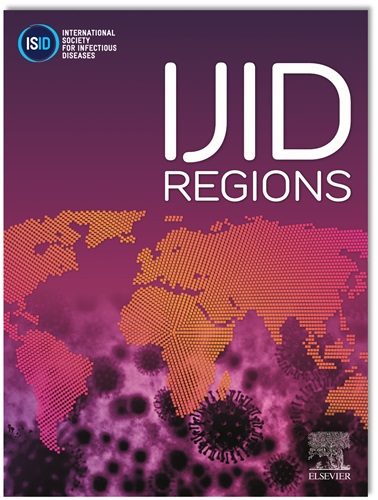在刚果民主共和国金沙萨,怀孕期间疟疾对婴儿神经发育的影响和生命第一年的疟疾易感性。
IF 4.3
2区 医学
Q1 INFECTIOUS DISEASES
引用次数: 0
摘要
背景:孕产妇疟疾可影响儿童神经发育,增加儿童早期疟疾易感性。这项研究比较了在分娩时感染或未感染疟疾的母亲所生婴儿的神经发育和疟疾易感性。方法:在分娩时招募388对母子。产妇疟疾在出生时通过显微镜进行评估,婴儿疟疾根据发烧史进行评估。在4-6周、6个月和12个月时使用马伦早期学习量表(MSEL)评估婴儿神经发育,其中包括大肌肉运动(GM)和早期学习综合(ELC)得分。根据分娩时接触疟疾情况,比较了婴儿疟疾发病率和神经功能。结果:385例婴儿中有62例(16.1%)在分娩时暴露于疟疾,镜检证实为外周和胎盘疟疾。这些暴露的婴儿出生体重(LBW)(2824.68±493.85 g)明显低于未感染母亲出生的婴儿(3032.69±487.8 g); = 0.0023页)。12个月GM组间无显著差异(暴露组平均GM评分:47.2±9.8 vs.未暴露组:47.6±9.7; = 0.757页)。然而,暴露于疟疾感染的婴儿ECL显著降低(-7.70 [95% CI: -15.0, -0.36]; = 0.04页)。婴儿疟疾、营养不良和低体重与GM评分降低显著相关(-1.2 [95% CI: -2.25, -0.18], p = 0.021;-0.96(95%置信区间CI: -1.92, -0.02),和-1.59(95%置信区间CI: -3.06, -0.11),分别)。疟疾发病率在12个月时达到高峰,暴露组的发病率为54.7%,而未暴露组的发病率为70.6% (RR = 1.04 [95% CI: 0.87-1.25], p = 0.631)。结论:分娩时的疟疾与ELC受损有关,但与GM无关。前12个月的疟疾易感性不受母体疟疾暴露的影响。然而,低体重、营养不良和婴儿疟疾影响了婴儿的发育。本文章由计算机程序翻译,如有差异,请以英文原文为准。
Impact of malaria in pregnancy on infant neurodevelopment and malaria susceptibility during the first year of life in Kinshasa, the Democratic Republic of the Congo
Objectives
To compare the neurodevelopment and malaria susceptibility of infants born to mothers infected or uninfected with malaria at the time of delivery.
Methods
A cohort of 388 mother–child pairs was recruited at delivery. Maternal malaria was assessed by microscopy at birth, and infant malaria was based on a history of fever. Infant neurodevelopment was evaluated at 4-6 weeks, 6 months, and 12 months using the Mullen Scales of Early Learning (MSEL), which include scores for gross motor (GM), and early learning composite (ELC). Infant malaria incidence and neurological functioning were compared based on malaria exposure at delivery.
Results
In total, 62/385 (16.1%) infants were exposed to malaria at delivery, confirmed by microscopy for both peripheral and placental malaria. These exposed infants had a significantly lower birth weight (LBW) (2824.68 ± 493.85 g) than those born of uninfected mothers (3032.69 ± 487.8 g; p = 0.0023). GM at 12 months showed no significant differences between groups (mean GM score for exposed: 47.2 ± 9.8 vs unexposed: 47.6 ± 9.7; p = 0.757). However, infants exposed to malaria infection had significantly lower ECL (−7.70 [95% confidence interval {CI}: −15.0, −0.36]; P = 0.04). Infant malaria, malnutrition, and LBW were significantly associated with reduced GM scores (−1.2 [95% CI: −2.25, −0.18], P = 0.021; −0.96 [95% CI: −1.92, −0.02], and −1.59 [95% CI: −3.06, −0.11], respectively). Malaria incidence peaked at 12 months, affecting 54.7% of the exposed group vs 70.6% of non-exposed infants (risk ratio = 1.04 [95% CI: 0.87-1.25], P = 0.631).
Conclusions
Malaria at delivery was associated with impaired ELC but not with GM. Malaria susceptibility during the first 12 months was not influenced by maternal malaria exposure. However, LBW, malnutrition and infant malaria impacted infant development.
求助全文
通过发布文献求助,成功后即可免费获取论文全文。
去求助
来源期刊
CiteScore
18.90
自引率
2.40%
发文量
1020
审稿时长
30 days
期刊介绍:
International Journal of Infectious Diseases (IJID)
Publisher: International Society for Infectious Diseases
Publication Frequency: Monthly
Type: Peer-reviewed, Open Access
Scope:
Publishes original clinical and laboratory-based research.
Reports clinical trials, reviews, and some case reports.
Focuses on epidemiology, clinical diagnosis, treatment, and control of infectious diseases.
Emphasizes diseases common in under-resourced countries.

 求助内容:
求助内容: 应助结果提醒方式:
应助结果提醒方式:


